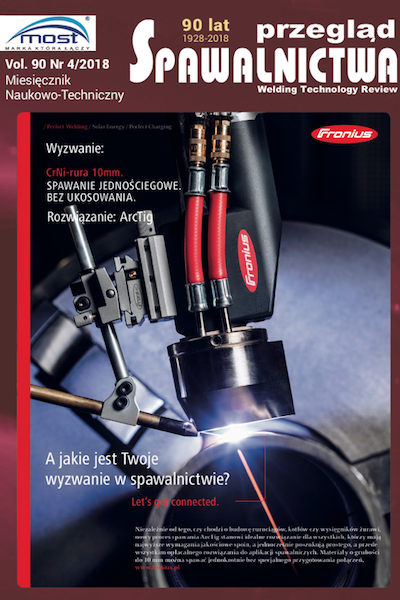Microstructure and mechanical properties of multi-layered Al/Ti composites produced by explosive welding
Main Article Content
Abstract
Microstructure and phase in the bonding zone of explosively welded Ti/Al multilayer clads were examined by optical microscopy and scanning electron microscopy. The defect-free multilayer composite was successfully formed. The macro-scale observations showed that the interfaces between joined plates presented mixed wavy/flat shape with solidified melt inclusions located preferentially at the crest of each wave and in the wave vortex. It was found that interfaces of wavy character were always formed in layers near the explosive charge and flattened with the increase of the distance from the top surface. The micro-scale analyses observations revealed a presence of very thin reaction layer at the flat parts of the joint plates and nano-grained struc- ture of melted zones.
in polish
Mikrostruktura i właściwości mechaniczne wielowarstwowych platerów na bazie Al i Ti wytwarzanych z wykorzystaniem energii wybuchu
W pracy analizowano zmiany mikrostrukturalne oraz formowanie się nowych faz w wielowarstwowych układach platerów zbudowanych na bazie Ti i Al. Wykorzystano techniki mikroskopii optycznej i skaningowej mikroskopii elektronowej, pomiary mikrotwardości, a także próbę zginania w warunkach udarowych. Obserwacje w skali makro pokazały, że w procesie spajania wytworzono 15-warstwowy plater wolny od nieciągłości strukturalnych. Powierzchnie połączenia uległy silnemu odkształceniu i wykazywały mieszany falisto-płaski charakter ze strefami przetopień preferencyjnie lokowanymi na grzbiecie oraz w zawinięciach fal. Zaobserwowano, że silnie pofalowane granice połączenia zawsze formowały się w warstwach położonych w pobliżu ładunku wybuchowego. Analizy w mikro skali udokumentowały występowanie cienkiej warstwy przetopionej o silnie rozdrobnionej strukturze.
Downloads
Article Details
Creative Commons CC BY 4.0 https://creativecommons.org/licenses/by/4.0/
Welding Technology Review (WTR) articles are published open access under a CC BY licence (Creative Commons Attribution 4.0 International licence). The CC BY licence is the most open licence available and considered the industry 'gold standard' for open access; it is also preferred by many funders. This licence allows readers to copy and redistribute the material in any medium or format, and to alter, transform, or build upon the material, including for commercial use, providing the original author is credited.
References
Blazynski T.Z.: Explosive Welding, Forming and Compaction, Applied Science Publishers LTD, New York, 1983.
Romberg J., Freudenberger J., Bauder H., Plattner G., Krug H., Holländer F., Scharnwe- ber J., Eschke A., Kühn U., Klauß H., Oertel C-G., Skrotzki W., Eckert J., Schultz L.: Ti/Al Multi-Layered Sheets: Accumulative Roll Bonding (Part A), Metals 6, 2016, pp. 30-44.
Veccio K.S.: Synthetic multifunctional metallic-intermetallic laminate composites, J. of Microscopy 57, 2005, pp. 25-31.
Chulist R., Fronczek D., Szulc Z., Wojewoda-Budka J.: Texture transformations near the bonding zones of the three-layer Al/Ti/Al explosively welded clads, Materials Characterization, 129, 2017, pp. 242-246.
Lazurenko D.V., Bataev I.A., Mali V.I., Bataev A.A., Maliutina Iu.N., Lozhkin V.Z., Esikov M.A., Jorge A.M.J.: Explosively welded multilayer Ti-Al composites: Structure and transformation during heat treatment, Materials and Design, 102, 2016, pp. 122-130.
Fronczek D., Wojewoda-Budka J., Chulist R., Sypień A., Kornewa A., Szulc Z., Schell N., Zieba P.: Structural properties of Ti/Al. Clads manufactured by explosive welding and annealing, Materials and Design, 91, 2016, pp. 80-89.
